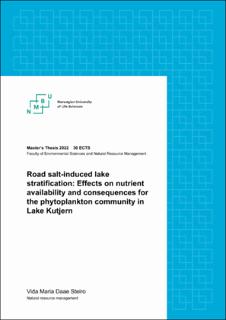| dc.description.abstract | In Norway, the use of road salt for de-icing highways has increased by more than 200 percent in the last two decades. This is partly due to climate change and increased traffic volumes, and hence may continue to rise. Salt is readily transported with runoff into the environment, where it can harm ecosystems, including lakes. In lakes, dense, salty water that sinks to the bottom may develop a chemical density gradient that prevents water circulation. Several Norwegian lakes are subject to road salt pollution and consequent changes in lake physicochemical conditions. Despite this, the impact of road salt on phytoplankton community composition in these lakes has not been extensively studied. This study aims to improve the understanding of the consequences of road salt runoff for algal community composition through examining a range of parameters in a humic, boreal lake highly affected by road salt. Measurements were conducted in Lake Kutjern from mid-May through mid-September 2021.
The study finds that road salt has led to chemical stratification, bottom water oxygen depletion, and likely caused meromixis (permanent stratification) in Lake Kutjern. This is the probable cause of bottom accumulations of iron and manganese, and depletion of sulfate and nitrate in the lake. The results also suggest that meromixis has led to ammonium accumulation in the bottom layer and nitrogen limitation at the top. Pigment analyses indicate that such conditions have led to the dominance of the nuisance alga Gonyostomum semen (Ehr.) Diesing (Raphidophyceae) and to green sulfur bacteria (Chlorobiaceae) blooms. These are potentially affecting nutrient distributions in the lake. Overall, this study contributes to the understanding of what consequences road salt may have on humic, boreal lakes, even after road relocation, and of the factors affecting G. semen growth. Such knowledge may be of importance for freshwater management into the future, as more lakes may be affected by road salt because of climate change and increased traffic. | en_US |

